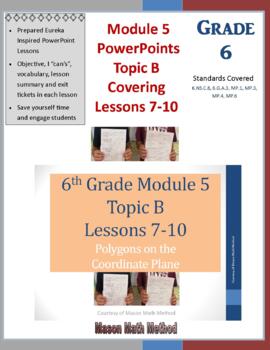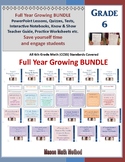6th Math Module 5 Topic B Lessons 7-10 PowerPoint Polygons & Coordinate Plane
- Zip
Also included in
- This download contains 6th grade math Module 5 Topic A-D Lesson 1-19 PowerPoint Lessons inspired from the Engage NY Eureka Math program. The topic includes the following: Area, Surface Area, and Volume Problems. These are self-made using other various resources in combination with Eureka inspired lPrice $51.63Original Price $73.75Save $22.12
- Yes, you read it correctly...a full year’s worth of 6th Grade Math PowerPoint Lessons ready for both in-class presentation or can be used to teach virtual classes. I am super excited to be offering you this exciting bundle that will get you through the entire year. These PowerPoint lessons are not sPrice $280.00Original Price $465.85Save $185.85
- This is a growing bundle. Please read the product description carefully to understand which resources are included and which have not yet been added.This bundle includes all of my 6th grade math material in my store. You will literally have everything you will need to teach 6th grade math with thisPrice $597.98Original Price $854.25Save $256.27
Description
This download contains 6th grade math Module 5 Topic B Lesson 7-10 PowerPoint Lessons inspired from the Engage NY Eureka Math program. The topic includes the following: Polygons on the Coordinate Plane. These are self-made using other various resources in combination with Eureka inspired lessons from Module 5. (Total 355 slides).
I created/put these PowerPoint lessons together to help me lead an engaging lesson that also covered all the things required such as objective, I “can” statements, vocabulary, lesson summary, and exit ticket.
Within these lessons I pulled out what I felt I needed or could use in the time I had. As you will see I mainly kept with the Eureka lesson but did add my own self-created items as well as inserted examples/problems from other sources to make sure I taught the standard the best I could. When you see a lesson description that says 1 or 2 day lesson that means it is a 1 day lesson that can be split into 2 day lessons if you want to go at a slower pace.
Remember that any Eureka lessons can be found on their website for FREE… and any other resources I used to make these PowerPoint lessons were found for free. This product is my own lesson plan on how I taught lessons using those resources.
If you were searching for PowerPoint’s that simply cut and pasted the lessons directly from Eureka then this is not the product for you. This product is custom and tailored to help teachers teach the Eureka lessons but in a format that will result with high student growth and achievement. If you are searching for lesson plans that are done for you with a PowerPoint to guide you through each lesson, breaking down the steps, and all you have to do is click from slide to slide with proven student growth then definitely download…I use these and they work!
These PowerPoint Lessons can easily be used for teaching virtually…all you need to do is click from slide to slide and all the answers are included making for easier teaching online as well as in the classroom.
I have 8 years teaching experience (1 year teaching 9th-10th grade health, 6 years teaching 5th grade math, and just finished teaching 6th grade math this year). I have been a level 5 teacher for the past 6 years. Below I have listed what you will be getting in this download.
If you are interested in obtaining my full Module 1-6 Bundle for the entire year please CLICK HERE.
If you are interested in obtaining my Full Module 5 Topic A-D Lessons 1-19 PowerPoint Bundle please CLICK HERE.
Below I have listed what you will be getting in this download.
Topic B
Module 5 Lesson 7-8 Mainly Teacher Toolbox Lesson 23 (2 Day Lesson Plan): (Title: Drawing Polygons & Finding Distance on a Coordinate Plane)
- 121 total slides covering
- Objective
- I “can” statement
- Vocabulary
- Day 1
- TT Lesson 23
- Opening Example (See Handout #1)
- TT Lesson 23
- Review SSS and DSA from Module 3 Lesson 18
- SSS (Same Sign Subtract)
- DSA (Difference Sign Add)
- Adding & Subtracting Absolute Numbers
- Eureka Lesson 7
- Example 1
- Eureka Lesson 7
- Day 2
- Eureka Lesson 8
- Example 1
- Eureka Lesson 8
- Day 2
- TT Lesson 23
- Example 5 (See Handout #1)
- Example 2 (See Handout #1)
- Test Question #7 (See Handout #1)
- Lesson Summary
- TT Lesson 23 Exit Ticket (See Handout #2)
- Eureka Lesson 7 Exit Ticket
Module 5 Lessons 9-10 Combo (1 or 2 day Lesson Plan): (Title: Distance, Perimeter, and Area on a Coordinate Plane)
- 143 total slides covering
- Objective
- I “can” statement
- Vocabulary
- Lesson 9
- Example 1-2
- Exercise 1a
- Lesson 10
- Opening Exercise B
- Lesson 10
- Lesson Summary
- Lesson 10 Exit Ticket
- Lesson 9 Exit Ticket Answers
Attention Districts and Departments: If you are purchasing for your school’s department, please buy the appropriate amount of licenses. If you are a large school district and you are interested in a full district license, please contact me for a district-wide quote.
LICENSING TERMS: This purchase includes a license for one teacher only for personal use in their classroom. Licenses are non-transferable, meaning they cannot be passed from one teacher to another. No part of this resource is to be shared with colleagues or used by an entire grade level, school, or district without purchasing the proper number of licenses. If you are a coach, principal, or district interested in transferable license to accommodate yearly staff changes, please contact me for a quote.
COPYRIGHT TERMS: This resource may not be uploaded to the internet in any form, including classroom/personal websites or network drives, unless the site is password protected and can only be accessed by students. Violations are subject to the penalties of the Digital Millennium Copyright Act.
If you are interested in my GROWING BUNDLE which includes not only these amazing and useful PowerPoint Lessons, but also Module 1-6 topic quizzes, mid-module, and end-of-module tests, interactive notebook/booklets, Know & Show Teacher Guide, and coming includes editable Lesson Plan Template, various 6th practice worksheets, activities, and recorded video lessons of each PowerPoint Lesson I created please CLICK HERE








